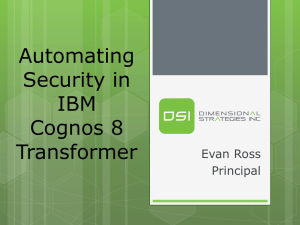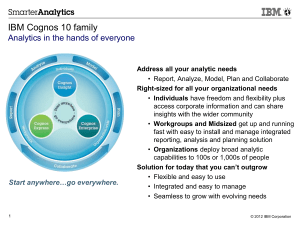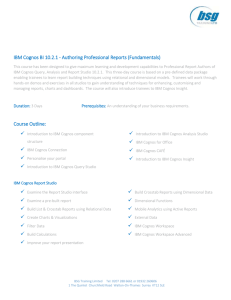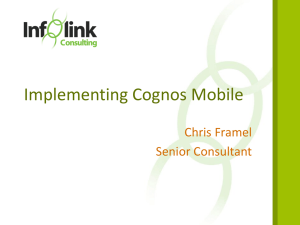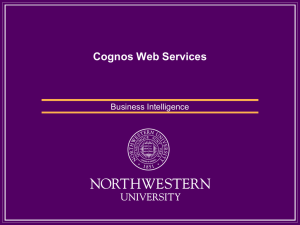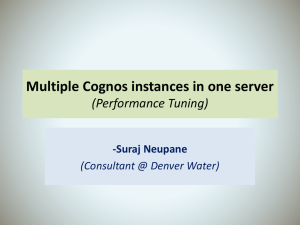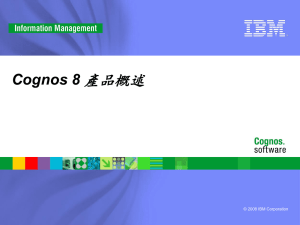Cognos is one of the oldest companies in the Business Intelligence
advertisement
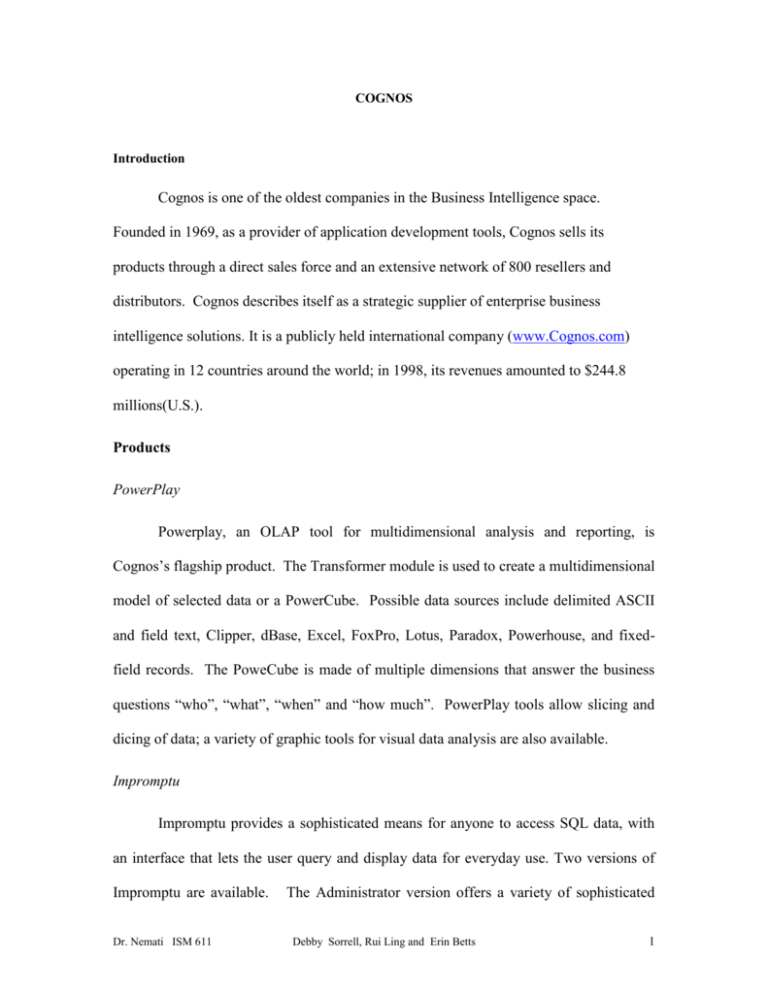
COGNOS Introduction Cognos is one of the oldest companies in the Business Intelligence space. Founded in 1969, as a provider of application development tools, Cognos sells its products through a direct sales force and an extensive network of 800 resellers and distributors. Cognos describes itself as a strategic supplier of enterprise business intelligence solutions. It is a publicly held international company (www.Cognos.com) operating in 12 countries around the world; in 1998, its revenues amounted to $244.8 millions(U.S.). Products PowerPlay Powerplay, an OLAP tool for multidimensional analysis and reporting, is Cognos’s flagship product. The Transformer module is used to create a multidimensional model of selected data or a PowerCube. Possible data sources include delimited ASCII and field text, Clipper, dBase, Excel, FoxPro, Lotus, Paradox, Powerhouse, and fixedfield records. The PoweCube is made of multiple dimensions that answer the business questions “who”, “what”, “when” and “how much”. PowerPlay tools allow slicing and dicing of data; a variety of graphic tools for visual data analysis are also available. Impromptu Impromptu provides a sophisticated means for anyone to access SQL data, with an interface that lets the user query and display data for everyday use. Two versions of Impromptu are available. Dr. Nemati ISM 611 The Administrator version offers a variety of sophisticated Debby Sorrell, Rui Ling and Erin Betts 1 tools for designating access rights to data and distributing it across the network. The User version provides a flexible GUI interface and a good selection of pre-designed data reports and templates and intuitive tools for creating custom reporting. It displays SQL data in catalogs. Catalogs can be created from a variety of SQL database types, including Btrieve, dBase, Informix, CA-Ingres, Borland InterBase, MS SQL Server, Oracle 6 and 7, P aradox, SQLBase, Sybase SQL Server and Sybase System 10. Scenario Scenario is Cognos’ award winning data mining application that features seamless integration with the firm’s Impromptu and PowerPlay programs. Designed to spot patterns and exception in data, Scenario’s intuitive interface allows users to visualize the information being uncovered. Scenario is an innovative data-mining tool that enables managers and knowledge workers to discover hidden trends and patterns, and unearth previously unsuspected correlations, without requiring them to have expert knowledge of statistical techniques. It uncovers the patterns and relationships that exist in business data, providing the insight needed to make informed, timely business decisions. 4Thought The 4Thought predictive modeling tool is Cognos’ acquired data mining product targeted at the business user. It automates what-if analysis, forecasting, and effectiveness measurement. 4Thought is integrated with Cognos’ other best-of-breed business intelligence tools, PowerPlay, Impromptu and Scenario. 4Thought can read PowerCubes directly allowing analyses based on summary data, or on the finest level of detail in the PowerCube. Impromptu reports can be used as a data source in 4Thought. This extends Dr. Nemati ISM 611 Debby Sorrell, Rui Ling and Erin Betts 2 4Thought’s data access to all the relational databases that Impromptu supports. Scenario output can be imported into 4Thought to build models or perform forecasts. 4Thought is based on neural network technology. The original idea behind neural network technology is to understand how the human brain works—how it can chew over a mess of data from the external world, how it recognizes coherent patterns, and how it associates these patterns into chains of cause and effect. In the early eighties, a small breakthrough occurred with the invention of the multilayer perceptron (MLP). The MLP exhibited a number of interesting properties giving it real practical value as a general mathematical modeling tool. Key MLP properties include: It builds models, which can take on arbitrary non-linear forms. The non-linear forms it assumes are plausible in real-world terms, e.g. they don’t tend to have infinities, or "overshoot" when they should be interpolating. They use a gentle fitting process (rather than directly minimizing squared error). Because the process doesn’t necessarily believe that all the data it is using is perfect, neural network models have a significant advantage over conventional modeling techniques such as regression, particularly with noisy data., co-linear data and small data sets. The gentle fitting process builds models, which emphasize greatest predictive ability rather than best fit to the data. Bise In November 98, Cognos introduced Bise 3.0 (Business intelligence for Small Enterprise ). While the ideal prospects are companies with annual revenues of up to $250 million, the solution reportedly allows small and midsize firms to have the same cost effective business intelligence benefits as larger companies. Bise 3.0 according to Cognos, provides an easy way for small firms to get off the ground with data marts of data warehousing projects at low cost and low risk. Dr. Nemati ISM 611 Debby Sorrell, Rui Ling and Erin Betts 3 Accelerator Sales Analysis for SAP R/3 marks Cognos’ first BI Application. Accelerator is the enabling technology that unlocks the business from the SAP environment. NovaView NovaView OLAP viewer (pre-release name Aristotle) is optimized for Microsoft’s SQL Server 7.0 (pre-release named Plato OLAP server). Cognos licensed the client software from Panorama (the same company from which Microsoft bought the source code for Plato). The front-end tool allows users to change and save data in a multidimensional OLAP Services cube, to facilitate what-if-analysis. Database administrators benefit form NovaView’s capability to support the creation of multidimensional data analysis that can be deployed in a read-only form for casual users. NovaView is a solid , inexpensive OLAP client to deploy. Visualizer Visualizer is designed to present data in a graphical format to make business-data presentation more meaningful. For example, features such as “traffic lighting” which is the ability to color-code data based on value provides easy comprehension. Users can fly through their data, having the graphic continuously change based on a give value. In other words, if users wanted to see company performance over time, the chart would change through a time series. Data Visualization provides graphical slicing and dicing. PowerHouse PowerHouse is a legacy application development tool. PowerHouse 4GL is the industry proven server-based application development environment from Cognos that Dr. Nemati ISM 611 Debby Sorrell, Rui Ling and Erin Betts 4 enables business-critical programs to be written quickly and modified easily. Based upon a strong data dictionary and sophisticated business data processing models, it supports simultaneous access to leading relational database management systems and proprietary file systems. Using a specification-based language, PowerHouse 4GL is used to build and run interactive screens and menus, volume batch processes, and flexible production reports. PowerHouse Web is an exciting new solution from Cognos for deploying PowerHouse 4GL screen programs to the Internet or corporate intranets. Using PowerHouse Web, in conjunction with the latest release of PowerHouse 4GL, developers can now build and deploy Web applications using the same robust and highly productive tools that are already used by thousands of organizations for their core business applications. The PowerHouse application server is available for platforms ranging from PCs running Windows 95, 98 or NT, through Windows NT servers and on up to the most powerful enterprise servers running UNIX, MPE/iX, OpenVMS and OS/400. Applications developed with the Cognos tools will scale to whatever number of users you need to support—today and in the future. Racing to the Enterprise Information Portal In the same way that Internet content portals are the gateway to the wealth of content on the Web, Enterprise Information Portals, EIPs, will provide ubiquitous access to business related information. EIPs will provide a personalized gateway to internally and externally stored information that is needed to make informed business decisions. Dr. Nemati ISM 611 Debby Sorrell, Rui Ling and Erin Betts 5 The market segments involved include Business Intelligence, Content Management, Data Warehouse/DataMarts and Data Management. Automation of the processes in an organization has lead to stores of data that continue to grow exponentially. This structured data, from Enterprise Resource Planning, ERP, systems, legacy systems and point of sales, feed on-line transactional databases. Management of this data (extract, transform and load (ETL) tasks, data cleaning, metadata management) enables the creation of data warehouses and data mart storage environments for use by OLAP, data mining, query and reporting Business Intelligence tools. Equally overwhelming is the growth of unstructured data such as word processing documents, e-mail, product specifications, project plans, forms, paper invoices and purchase orders, web documentation, R&D documentation and endless other unstructured data forms. Some estimates put unstructured data as high as 80% of an organization’s data (Merill Lynch 11-16-98). When one adds external resources available on the Internet and audio and video files, not only the volume but also the complexity of content management becomes obvious. Content Management systems capture, archive, index, manage, combine and distribute internal and external information to create a corporate knowledge repository and have evolved from document management systems. Even “softer” data resides in the heads of experts and flows yet untapped from the collective minds engaged in countless projects, implementations and even failures. The development of Knowledge Management systems that either fuse with Content Management systems or take on a life of their own is yet to be seen. Regardless, Dr. Nemati ISM 611 Debby Sorrell, Rui Ling and Erin Betts 6 enterprise portals will be the keyhole through which both structured and unstructured information is unlocked and accessed from anywhere by employees, customers and suppliers via the Internet distribution channels (Internet, Intranet and Broadcasting). It is around this vision of the future that Cognos states in their 1999 annual report “we want Enterprise Business Intelligence, EBI, from Cognos to ultimately transform the way companies run their business”. Product releases and acquisitions show that Cognos is marching toward this goal. In November 1998, Impromtu Web Reports was released providing a single Webbased interface from which users can perform reporting activities that suit their individual needs. In December 1998, Cognos acquired the assets of Relational Matters and its DecisionStream software. DecisionStream provides a simple, integrated approach to loading and managing data marts. In February 1999, LEX2000 Inc. was acquired for best-of-breed financial reporting and budgeting. The product is marketed as Cognos Financials. Also in February, PowerPlay Enterprise Server was released as the only OLAP application server that supports Web, Windows, Microsoft Excel and mobile users from a single, centrally administered server. September 7th 1999, the Cognos Platform for Enterprise BI was introduced. Dr. Nemati ISM 611 Debby Sorrell, Rui Ling and Erin Betts 7 Cognos Platform for Enterprise Business Intelligence (EBI) The Cognos Platform for Enterprise Business Intelligence (EBI) was built from the ground up to meet the new challenges of enterprise deployments (see exhibit 1). It is a complete foundation for building BI applications and includes five service layers. Portal Services: Portal Services, called Upfront, provide a single Web-based delivery infrastructure that gives users a single point of personalized access to BI and non-BI content and gives IT a single point of delivery and management. Portal Services support end-user publishing of Cognos and other business content and have a programmable XML API for user interface customization and functionality integration. EBI Services: The EBI Services address all users’ (inside and outside of an organization) business intelligence needs from a common infrastructure. It includes updated versions of Cognos BI servers for both UNIX and NT: PowerPlay (Analysis) and Impromptu (Reporting), as well as new Cognos Servers: Cognos Query (Query) and Cognos Visualizer (Visualization). All BI Servers are based on a scaleable, distributed architecture with load-balancing and fail-over protection. Updates to BI servers include: Managed web reporting with prompts against OLAP data structures (delivered to Web browser users in highly formatted and printable PDF outputs). PowerPrompts, powerful application front-ends to reports, allow report authors to create a single report that can service many different needs. These application front- Dr. Nemati ISM 611 Debby Sorrell, Rui Ling and Erin Betts 8 ends are completely customizable with industry-standard languages such as, HTML, XML and Java. Improved ad hoc Web interaction against OLAP data sources including drillable 3-D charts, calculations, and new dynamic HTML interfaces. More powerful ad hoc web interaction relational data sources including: advanced calculations, direct query manipulation for grouping/sorting/filtering/moving/columns, cross-tabs, new chart types Advanced visualizations and score carding over the Web Metadata Services: Metadata Services, called Architect, address the need for common enterprise-wide metadata management by providing a central place to create and manage all business intelligence metadata and business rules. Using Metadata Services, a single metadata model can be created that spans all enterprise data sources and all enterprise BI applications. This is accomplished through a three-tiered architecture that isolates the business rules form the data sources and the end applications. This architecture will also dramatically reduce the amount of time organizations will spend adapting their applications for change because all changes made in the business rule tier are automatically inherited by any affected BI application. BI Data Mart Creation Services: The BI Data Mart Creation Service, called DecisionStream, supports the requirements for a data infrastructure that is BI specific and Dr. Nemati ISM 611 Debby Sorrell, Rui Ling and Erin Betts 9 enterprise wide. This service contains BI mart modeling, transformation and creation tools that supports shared, conformed cross-enterprise dimension. Common Security Services: A common security service, called Access Manager, allows IT to manage and maintain users and user classes for all Cognos EBI Servers from a single place. It allows for easy integration with other security mechanisms such as RDBMS, OS and LDAP through its programmable API. Other Portal Players Close on the heels of the announcement of the Cognos Platform for Enterprise BI, Oracle announced a Portal Framework to be released in 2000. The framework employs reusable components, called portlets, to point to any information source, including applications, databases and other portals. It will give users and business partners consistent views and services throughout intranets and extranets. A portlet is a set of standard Java APIs that wrap around any content source. The content source can be a document, an application, or commonly requested pieces of information such as reports, employee lists or external information from the Internet. The framework and portlet tools will be integrated into Oracle WebDB version 3.0 currently in beta testing. IBM announced the IBM Enterprise Information Portal on November 2nd. The IBM EIP can integrate structured and unstructured data regardless of the vendor, location or type. For example, information can be accessed from document and media management, Web, spreadsheets, e-mail, audio and video XML/HTML applications, and others. Dr. Nemati ISM 611 Debby Sorrell, Rui Ling and Erin Betts 10 Hummingbird Communications Ltd., known for it’s terminal emulation and PCto-Host communications market leadership, is pursing the EIP market by it’s purchase of Andyne Computing, a developer of business intelligence software and PCDOCS document management software. Hummingbird’s president, Jim Toblin stated that Hummingbird has all the foundation technologies needed for an EIP solution, Universal Data Exchange, BI, Data Mining, Analytical Applications, Collaborative Knowledge Management and Document Management. The Internet has created an information explosion and has made a fundamental change in the way companies do business. Cognos plans to be a key player in this transition; long standing partners are become direct competitors. Their past strengths in getting the business user the data they need in a form that they can use will marry well with the impending ambiguous browser anywhere user interaction modes rapidly evolving. Dr. Nemati ISM 611 Debby Sorrell, Rui Ling and Erin Betts 11 Exhibit 1 Dr. Nemati ISM 611 Debby Sorrell, Rui Ling and Erin Betts 12 References: Biggs, Maggie, Review: Cognos aptly powers up OLAP, April 5, 1999, Enterprise Computing, Vol. 21, Issue 14, http://archive.infoworld.com/cgib…layArchive.pl?/99/14/e06-14.73.htm Cognos 1999 Annual Report, http://www.cognos.com/ Cognos Introduces First End-to-End Platform for True Enterprise Business Intelligence Solutions, Orlando, Fl, Enterprise ’99, September 7,1999, http://www.cognos.com/whatsnew/rel_244.html Guly, Chrispopher, Cognos looks to long-term gain, Software company ready to forgo short-term profits so it can invest in efforts to increase its market share, October 8, 1999, The Ottawa Citizen, http://www.ottawacitizen.com/hightech/present/991006/2957080.html Hohman, Robin Schreier, Oracle Portal Software Unifies Apps, Data, InternetWeek, http://www.techweb.com/wire/story/TWB19990922S0008 IBM unveils new e-business portal initiative, http://www.ibm.com/news/19999/11/022.phtml Introducing a Sophisticated New Approach to Addressing Enterprise BI Requirements, A New Technology Media Backgrounder, http://www.cognos.com/whatsnew/platforminbg.html Lattig, Michael, Cognos brings business intelligence lineup under one tent, InfoWorld Electric, September 7, 1999, http://www.infoworld.com/cgibin/displayStory/.pl?999097.eccognos.htm Shilakes, Christopher C. and Tylman, Julie, Enterprise Software Team, Enterprise Information Portals, Move Over Yahoo!; the Enterprise Information Portal Is on Its Way, Merrill Lynch & Co. RC#60232206 pages 1 to 64. Tyo, Jay, Cognos dresses up data but adds user complexity, InfoWorld, August 9, 1999, Vol. 21, Issue 32, wysiwyg://64/http://www.infoworld.com/cgi-bin/displayArchive.pl Whiting, Rick, Portal Software to Debut—Business-Intelligence Platforms Will Integrate Analysis Tools, Ease Management, September 6, 1999, InformationWeek Issue: 751, http://www.techweb.com/se/directlink.cgi?IWK19990906S0028 “Working in the E-economy with Enterprise Information Portals”…Featuring Jim Tobin, President Hummingbird Communications, http://www.hummingbird.com/ Dr. Nemati ISM 611 Debby Sorrell, Rui Ling and Erin Betts 13
